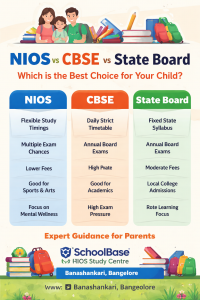As parents, we often find ourselves at a crossroads, wondering if the traditional schooling system is truly the best fit for our child’s unique personality. We want them to succeed, but not at the cost of their smile, their sleep, or their spirit.
While CBSE and State Boards have long been the “standard,” the National Institute of Open Schooling (NIOS) is emerging as a powerful alternative. Let’s look at how these choices impact your child’s daily life and mental well-being beyond the classroom walls.
NIOS vs CBSE vs State Board: Key Differences Parents Should Know
In a traditional CBSE or State Board setup, a child’s life is often dictated by the school bell. From the early morning rush to the afternoon commute and evening coaching, “free time” is a luxury. For many families, this leaves very little room for bonding or shared meals.
NIOS flips this script. It gives the power of time back to the student and the parent. Because there are no mandatory physical classes, the day can be structured around the child’s most productive hours. If your child is a budding athlete or a musician, NIOS allows them to practice during the day when facilities are best, shifting study time to the evening. This flexibility reduces the “rush” and creates a calmer home environment.

The Homework and Project Burden
One of the biggest stressors in a household is the nightly battle over homework. In CBSE and State Boards, heavy daily assignments and rigid project deadlines are the norm. This often leads to “extra burden” where the child is merely completing tasks to avoid punishment rather than learning.
In contrast, NIOS focuses on “Tutor Marked Assignments” (TMAs). These are fewer in number and designed to be completed over a longer period. It removes the daily “panic” of unfinished work, allowing a child to dive deeper into subjects they actually enjoy without a looming deadline every morning.
Conquering Exam Fear and Academic Stress
“Exam fever” is a real phenomenon in India. The high-pressure environment of CBSE—where one’s entire future feels tied to a single set of weeks in March—can be crushing for an average student. The fear of failure often leads to burnout and a lack of self-confidence.
NIOS approaches assessment with empathy. It offers “On-Demand” exams and the ability to “Part-Pass.” This means if a child isn’t ready for all five subjects at once, they can take two in April and three in October. Breaking the mountain into smaller hills makes the climb manageable and significantly reduces the mental health risks associated with academic pressure.
Nurturing Mental Well-Being
The “average student mentality” is often a byproduct of a system that compares everyone by the same yardstick. In a State Board or CBSE classroom, a child who struggles with Math but excels in Art might feel “less than” their peers.
NIOS encourages a different mindset. By allowing students to choose vocational subjects like Data Entry, Bakery, or Web Designing alongside core academics, it validates their strengths. When a child succeeds in what they love, their overall confidence grows, and they stop seeing themselves as “average.”
The Financial Reality: Fees and Extra Costs
We cannot ignore the financial stress on a family. Private schools affiliated with CBSE come with heavy annual fees, bus charges, uniforms, and constant “activity” expenses. State Boards are more affordable but still require daily operational costs.
NIOS is remarkably cost-effective. With low registration fees and no “hidden” school costs, it eases the financial burden on parents. This saved capital can instead be invested in specialized coaching for your child’s specific interests, whether that’s a professional sports academy or advanced coding classes.
Making the Final Choice
If your child thrives in a structured, competitive environment and has clear goals for national entrance exams, CBSE provides a strong, disciplined foundation. If you want to leverage local quotas and a regional curriculum, State Boards are a practical route.
However, if your child’s mental well-being is being affected by the “rat race,” or if they have a talent that requires hours of dedication outside of a textbook, NIOS is a breath of fresh air. It isn’t a “lesser” board; it is a more “human” board that recognizes that every child’s path to the future is different.
FAQ SECTION FOR BLOG
Q1. Is NIOS valid and recognized in India?
Yes. NIOS is recognized by the Government of India and accepted by universities, colleges, and professional institutions across the country.
Q2. Can NIOS students get admission in PUC, diploma and degree colleges?
Yes. NIOS students are eligible for PUC, diploma, and degree programs based on subject eligibility and college admission rules.
Q3. Can NIOS students write CET and COMEDK exams?
Yes, NIOS students can appear for CET, COMEDK and other entrance exams if they have the required subjects and minimum marks as per exam guidelines.
Q4. Is NIOS suitable for slow learners and average students?
Yes. NIOS is very helpful for slow learners and average students because it offers flexible learning and multiple exam chances.
Q5. Can sports and arts students study through NIOS?
Yes. Many sports and performing arts students choose NIOS because it allows flexible schedules along with training.
Q6. Does NIOS have practical exams and assignments?
Yes. NIOS has Tutor Marked Assignments (TMAs) and practical exams for science and vocational subjects, similar to other boards.
Q7. Is NIOS accepted for passport and abroad studies?
Yes. NIOS certificates are valid for passport applications and higher studies abroad, subject to university and country requirements.
Q8. Will students lose one year if they shift to NIOS?
No. With proper planning and correct admission cycle, students can continue education without wasting a year.
